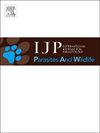Natural life cycle and molecular characterization of Taenia talicei Dollfus, 1960 (Cestoda: Taeniidae) from northwestern Patagonia, Argentina
IF 2
3区 医学
Q3 ECOLOGY
International Journal for Parasitology-Parasites and Wildlife
Pub Date : 2024-12-24
DOI:10.1016/j.ijppaw.2024.101035
引用次数: 0
Abstract
Through morphological and molecular studies, the natural life cycle of Taenia talicei Dollfus, 1960 (Cestoda: Taeniidae) from Argentine Patagonia is elucidated, involving subterranean rodents (Ctenomyidae) as intermediate hosts, and the Andean fox Lycalopex culpaeus (Canidae) as definitive host. Metacestodes (mono- and polycephalic fimbriocerci) were found mainly in the peritoneal cavity of Ctenomys terraplen, and the strobilate adult in the intestine of L. culpaeus. Correspondence between metacestodes and strobilate adults was based primarily on number, size and shape of rostellar hooks: 45–53 hooks alternated in two rows, small hooks 88–180 μm long and large hooks 230–280 μm long, with the characteristic shape described in the two main description of the species, both that of the metacestode (original description) and that of the strobilate adult (obtained experimentally). Further genetic analysis (cox1 gene mtDNA) corroborated the conspecificity between the metacestodes and the strobilate adults found in the Andean fox in the same study area. Genetic analysis also revealed conspecificity of the taxon found in Patagonia with the species registered in GenBank as T. talicei, obtained from different intermediate and definitive hosts from Peru and Argentina. Taenia talicei was previously reported from Argentina in the form of metacestodes naturally infecting two other species of Ctenomys. However, the strobilate adult was only described from the experimental infection of a domestic dog. Hence, this is the first report of the natural life cycle of T. talicei and of a species of Taenia endemic from South America.

阿根廷巴塔哥尼亚西北部talicei Dollfus的自然生活史和分子特征(绦虫科:带绦虫科)。
通过形态学和分子生物学研究,阐明了阿根廷巴塔哥尼亚带绦虫(Taenia talicei Dollfus, 1960)的自然生活史,其中以地下啮齿动物(带虫科)为中间寄主,安第斯狐狸Lycalopex culpaeus(犬科)为终寄主。其中单头和多头毛囊蚴主要分布在水蛭的腹膜腔内,双头成虫主要分布在水蛭的肠道内。双翅成虫和双翅成虫之间的对应关系主要基于双翅成虫的钩的数量、大小和形状:45-53个钩在两排中交替出现,小钩长88-180 μm,大钩长230-280 μm,具有双翅成虫(原始描述)和双翅成虫(实验获得)两种主要描述的特征形状。进一步的遗传分析(cox1基因mtDNA)证实了在同一研究区域发现的安第斯狐中发现的双足和双足的同质性。遗传分析还表明,在巴塔哥尼亚发现的分类群与在GenBank中登记为T. talicei的物种具有同源性,这些物种来自秘鲁和阿根廷的不同中间和最终宿主。以前曾报告阿根廷以粘足绦虫的形式自然感染另外两种绦虫。然而,strobilate成虫只被描述为来自一只家犬的实验性感染。因此,这是第一次报道塔利塞绦虫和南美洲特有带绦虫的自然生命周期。
本文章由计算机程序翻译,如有差异,请以英文原文为准。
求助全文
约1分钟内获得全文
求助全文
来源期刊

International Journal for Parasitology-Parasites and Wildlife
Medicine-Infectious Diseases
CiteScore
3.80
自引率
5.60%
发文量
113
审稿时长
45 days
期刊介绍:
The International Journal for Parasitology: Parasites and Wildlife (IJP-PAW) publishes the results of original research on parasites of all wildlife, invertebrate and vertebrate. This includes free-ranging, wild populations, as well as captive wildlife, semi-domesticated species (e.g. reindeer) and farmed populations of recently domesticated or wild-captured species (e.g. cultured fishes). Articles on all aspects of wildlife parasitology are welcomed including taxonomy, biodiversity and distribution, ecology and epidemiology, population biology and host-parasite relationships. The impact of parasites on the health and conservation of wildlife is seen as an important area covered by the journal especially the potential role of environmental factors, for example climate. Also important to the journal is ''one health'' and the nature of interactions between wildlife, people and domestic animals, including disease emergence and zoonoses.
 求助内容:
求助内容: 应助结果提醒方式:
应助结果提醒方式:


